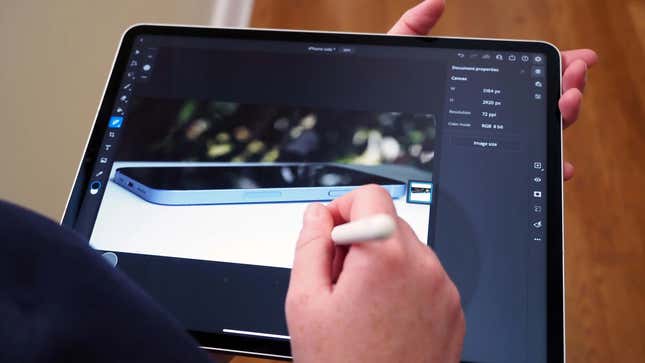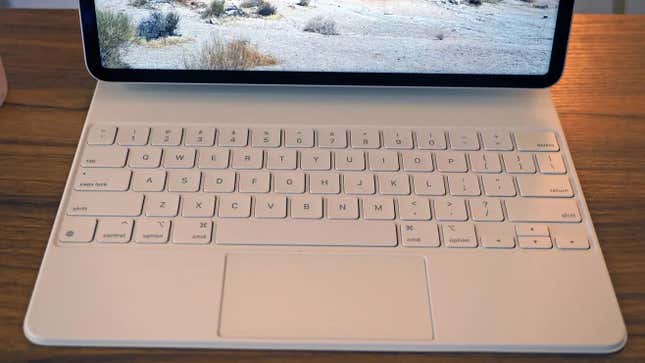The rumor tornado that has circled the upcoming OLED iPad Pro has finally started to wane, leaving us with a whole field scattered with little nuggets of information relating to its size, color options, and a few juicy details surrounding the new look on its OLED screen. The new school iPad Pro and iPad Air are supposed to drop early this year, potentially as soon as March, so we only have a few weeks to get excited about Apple’s first real push into OLED outside its phones.
Apple didn’t release any 11th-gen iPads last year, which is something to note, considering the Cupertino, California company has released one yearly for over a decade. The rumors make it clear that Apple thinks this latest refresh is a big one, and it could possibly reinvent the somewhat confusing SKU bloat that’s hindered the tech giant’s tablet line for years.
When Could Apple Release the OLED iPad Pro?
Most rumors suggest that March is Apple’s big month for the first half of 2024. The company just released its new M3 MacBook Airs with a 13- or 15-inch screen, which either means Apple might delay the iPad release to spare fans’ wallets, or it could keep the proverbial Eye of Sauron that is the tech media space pointed at it, and it alone.
In January, Bloomberg’s Apple guru Mark Gurman reported that Apple has wide-ranging designs that make March a big release month. He doubled down on the company’s plans to release the new M3 and OLED iPads this month, further saying Apple will likely have some OLED iPad debut toward the end of March. This would mean a full release sometime at the end of March or early April.
Moreover, there’ve been hints at additional iPad accessories that could also find their way onto the scene, along with the new Airs and Pros. People digging into the code for iOS 17.4 found mentions of an Apple Pencil 3 that connects with Apple’s Find My app. With a surprise release last year, the previous Apple Pencil featured a slide-out USB-C slot. That pencil version also lacked pressure sensitivity, so a new version with more sensitivity options could fit well with the new “Pro” lineup.
But wait, there’s more. Gurman previously mentioned that Apple is trying to redesign the Magic Keyboard to work with the iPad. Rumors suggest the new keyboard will have a larger trackpad. Most importantly, Apple could switch to aluminum for the top portion of its keyboard, which would give it much more of a MacBook feel than ever before. The cover material would remain the same, but it would make the whole keyboard a lot sturdier for those who want to use their iPad as their main daily driver.
What Do We Know About the iPad Pro’s OLED?

Based on routine hints by industry analysts, it’s become well-known that Apple wants to make an 11.1-inch and a 13-inch iPad Pro with OLED. That’s compared to the most recent 12.9-inch mini-LED version (called Liquid Retina XDR) and 11-inch IPS LCD version that currently occupy the top end of Apple’s tablet line. Those rumors have been reconfirmed by the most recent word from
The new generation of iPads will be sized slightly differently from previous models. 9to5Mac reported, based on anonymous sources, that the new iPad Pros will be close to 1 mm less thick than the current 10th-gen. The existing 11-inch iPad Pro is 5.9 mm thick, but the new one could be 5.1 mm. The 12.9-inch version currency sits at 6.4 mm, but the new one could be a bare 5.0 mm.
How Powerful Will the OLED iPad Pro Be?
We’ve known for a long while now that Apple wants to use its new M3 chip inside the iPad Pro. This was before we even had a chance to look at and analyze the power and capabilities of Apple’s latest M-series silicon, but since then, we’ve had the full chance to test out the capabilities of the 3nm M3 and its more powerful brethren, the M3 Pro and M3 Max.
Most configurations of the M3 for both the MacBook Air and MacBook Pro come with 8 CPU cores and either 8 or 10 GPU cores. These configurations either come with 8, 16, or 32 GB of RAM, though considering the iPad Pro goes to a maximum of 16 GB of integrated memory, you can expect the OLED version to be the same.
We’ve found the M3 chip to be pretty versatile at both productivity and graphical tasks. It’s marginally better than the M2 chip in all benchmarks, so it will certainly be an upgrade for those used to the M1 or M2 versions, even ignoring the new eye-catching display.
How Much Will the OLED iPad Pro Cost?

OLED normally costs more than LCD, partly because of materials and partly because fewer factories and makers are available to manufacture the individual components. Based on industry sources, Korean tech rumor site The Elec (via MacRumors) claimed that Samsung is producing the first batch of the 11-inch OLED iPads but that LG is also working on the 13-inch versions.
The Elec also noted that industry analysts expect Apple to ship 8 million units this year. That’s less than what the industry thought the company would ship last year, though it may be based on expected demand more than anything. Apple did have a few issues last year with MacBook sales being down, leading the company to release the M3 MacBook Pros not even a year after it finally started shipping the M2 version. This did help build hype around the M3 chip, the company’s most powerful APU released.
That said, the iPad Pro would only make sense to see a price increase. Trying to guess an exact price would be like tossing darts blindfolded, but the 13-inch iPad Pro currently starts at $1,099 but can go upwards of $2,000 if you want to opt for more storage options and cellular connectivity. We could guess that a new iPad Pro would cost at least $100 more than the current generation. The Elec has previously reported the next iPad could cost several hundred dollars more, even putting the price at $1,500 for the 11-inch and $1,800 for the 18-inch model, which seems to be a higher jump than seems practical.
Also, considering the Magic Keyboard’s current starting price of $300, a new aluminum material will likely increase the overall cost. The future iPad Pro will be a much more luxury product, which will also recast the Air as a more consumer-grade product overall.

